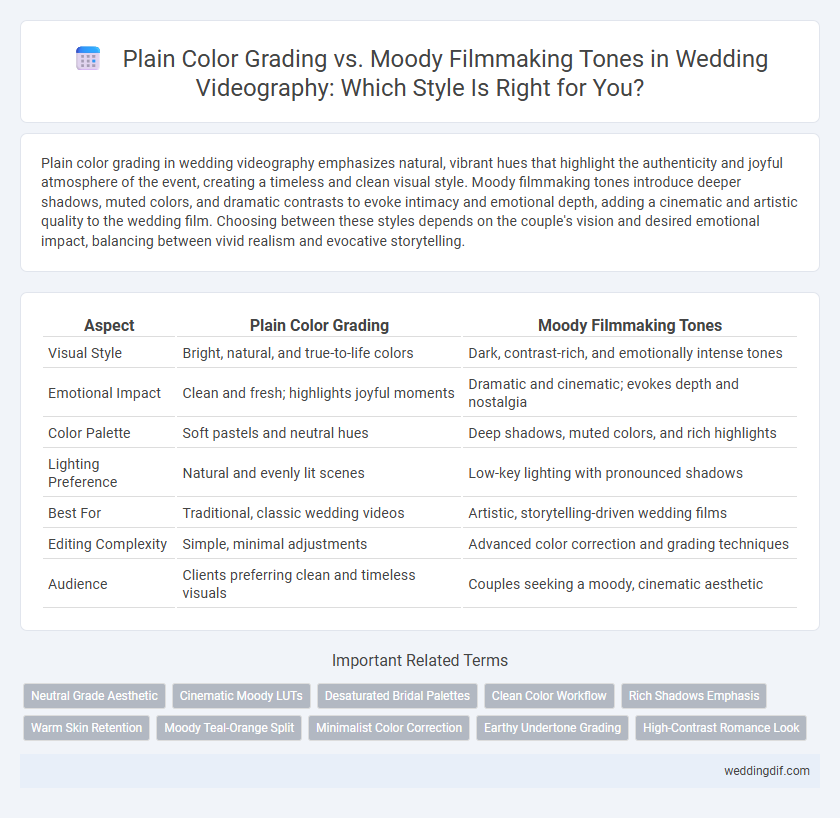Plain color grading in wedding videography emphasizes natural, vibrant hues that highlight the authenticity and joyful atmosphere of the event, creating a timeless and clean visual style. Moody filmmaking tones introduce deeper shadows, muted colors, and dramatic contrasts to evoke intimacy and emotional depth, adding a cinematic and artistic quality to the wedding film. Choosing between these styles depends on the couple's vision and desired emotional impact, balancing between vivid realism and evocative storytelling.
Table of Comparison
| Aspect | Plain Color Grading | Moody Filmmaking Tones |
|---|---|---|
| Visual Style | Bright, natural, and true-to-life colors | Dark, contrast-rich, and emotionally intense tones |
| Emotional Impact | Clean and fresh; highlights joyful moments | Dramatic and cinematic; evokes depth and nostalgia |
| Color Palette | Soft pastels and neutral hues | Deep shadows, muted colors, and rich highlights |
| Lighting Preference | Natural and evenly lit scenes | Low-key lighting with pronounced shadows |
| Best For | Traditional, classic wedding videos | Artistic, storytelling-driven wedding films |
| Editing Complexity | Simple, minimal adjustments | Advanced color correction and grading techniques |
| Audience | Clients preferring clean and timeless visuals | Couples seeking a moody, cinematic aesthetic |
Understanding Plain Color Grading in Wedding Videography
Plain color grading in wedding videography emphasizes natural and neutral tones, preserving the authenticity of the scene while enhancing clarity and brightness. This approach maintains true-to-life skin tones and environmental colors, ensuring that the wedding footage feels timeless and unaltered. Videographers choose plain grading to create a clean, elegant aesthetic that highlights the genuine emotions and details of the ceremony without dramatic color manipulation.
Defining Moody Filmmaking Tones for Weddings
Moody filmmaking tones for weddings emphasize subdued color palettes, deep shadows, and high contrast to evoke emotional depth and intimacy. This style often incorporates muted blues, rich earth tones, and subtle desaturation to create a cinematic atmosphere. Unlike plain color grading, moody tones enhance narrative storytelling by highlighting dramatic moments and enhancing the overall wedding film's emotional impact.
Emotional Impact of Color Grading Choices
Plain color grading in wedding videography creates a clean, fresh aesthetic that highlights natural emotions and vibrant details, fostering a sense of purity and joy. Moody filmmaking tones use deeper shadows and muted hues to evoke intimacy and nostalgia, enhancing the emotional depth of heartfelt moments. Choosing the right color grading style shapes the viewer's emotional response, either emphasizing lighthearted celebration or profound romantic connection.
Visual Consistency: Plain vs Moody Tones
Plain color grading in wedding videography emphasizes visual consistency through uniform hues and brightness, creating a clean, timeless look that highlights natural skin tones and soft backgrounds. Moody filmmaking tones utilize deeper shadows, heightened contrast, and rich color palettes to evoke emotional depth and drama, offering a stylized, cinematic feel that varies lighting intensity across scenes. Choosing between plain and moody tones impacts narrative cohesion, with plain grading ensuring subtle, consistent visual storytelling, while moody tones prioritize atmospheric variation and emotional resonance.
Storytelling Through Color: Which Approach Suits Your Wedding?
Plain color grading in wedding videography maintains natural, true-to-life hues that highlight authentic emotions and clarity, ensuring the story feels genuine and timeless. Moody filmmaking tones employ desaturated colors, deep shadows, and dramatic contrasts to evoke intense emotional depth, adding a cinematic and romantic atmosphere to the narrative. Choosing between these approaches depends on whether the couple prefers a realistic portrayal or an artistic, emotionally charged visual story that enhances the wedding's ambiance.
Client Preferences: Traditional vs Artistic Aesthetics
Clients seeking traditional wedding videography often prefer plain color grading, which emphasizes natural skin tones and true-to-life colors, creating a timeless and clean aesthetic. In contrast, those favoring artistic aesthetics lean towards moody filmmaking tones that use desaturated colors, high contrast, and shadows to evoke emotional depth and a cinematic feel. Understanding client preferences between these styles is crucial for tailoring videography to reflect either classic elegance or creative storytelling.
Editing Workflow: Simplicity vs Creative Complexity
Plain color grading in wedding videography emphasizes a straightforward editing workflow, offering consistent tones with minimal adjustments that streamline post-production and ensure quick turnaround times. Moody filmmaking tones demand a more complex editing process, involving meticulous color corrections and layer adjustments to evoke emotional depth and atmosphere, significantly extending project timelines. Choosing between these approaches depends on balancing efficiency and creative expression to match client expectations and stylistic goals.
Impact on Venue and Decor Representation
Plain color grading enhances the natural lighting and true-to-life hues of the wedding venue and decor, preserving authenticity and allowing intricate details to remain sharp and vibrant. Moody filmmaking tones introduce deeper shadows and muted color palettes that create a dramatic atmosphere, often emphasizing emotion but potentially muting the brightness and specific colors of floral arrangements and decorations. Choosing between these styles affects how the venue's ambiance and decor visual storytelling are conveyed, influencing the overall mood and viewer perception of the wedding environment.
Popular Trends in Wedding Film Color Grading
Popular trends in wedding film color grading emphasize the contrast between plain color grading and moody filmmaking tones. Plain color grading uses soft, natural hues to create a timeless, elegant aesthetic that highlights the purity of wedding moments. Moody filmmaking tones employ deeper shadows and rich contrasts to evoke intimacy and emotional depth, appealing to couples seeking a cinematic and dramatic style.
Choosing the Right Style for Your Wedding Memories
Selecting the right color grading style for wedding videography impacts the emotional tone and timelessness of your memories. Plain color grading emphasizes natural skin tones and vibrant colors, ensuring a clean, crisp look that highlights the joy and clarity of the day. Moody filmmaking tones enhance depth and atmosphere with desaturated hues and contrast, creating a cinematic, intimate feel that preserves the emotional gravity of wedding moments.
Plain Color Grading vs Moody Filmmaking Tones for wedding. Infographic

 weddingdif.com
weddingdif.com